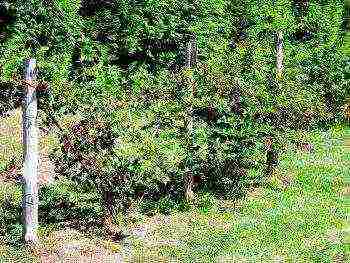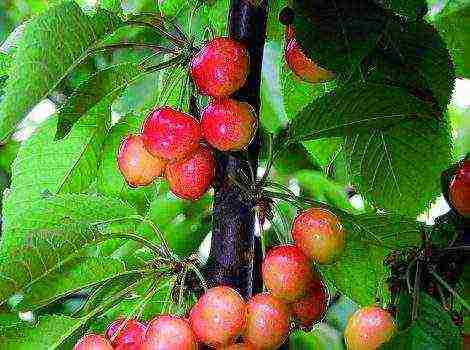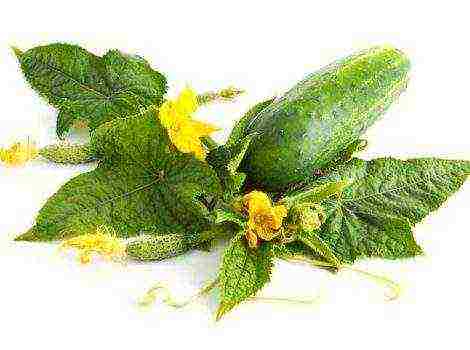Content
- 1 Soil and fertilizer for dogwood
- 2 Dogwood varieties are the best
- 3 Growing dogwood - video
- 4 "Who is" dogwood?
- 5 Is the berry sweet?
- 6 Where can you find dogwood?
- 7 Features of cultural cultivation
- 8 Dogwood in the gardens of Belarus
- 9 Dogwood in the suburbs
- 10 How to plant a seedling correctly?
- 11 Nuances of seed growing dogwood
- 12 Easy bush care
The plant got its name from the color of its fruits. In the family of Turkic languages, kizil (Tatar version - kyzyl) is translated as "red". The cultivation of this shrub is most common in the southern regions.
However, many varieties tolerate frost and drought without problems. This is explained by the fact that the dogwood has a strong root system, which goes underground for a meter or more. This allows the plant to extract moisture from both sandy soil and rocky soil.
Adult shrubs grow up to 7 meters, there are also decorative dogwood varieties that outwardly resemble a small tree up to 9 meters high.
Dogwood fruits are tied and ripen for a very long time. The plant begins to bloom in March, and the berries ripen only after 5-6 months.
Growing dogwood in the suburbs and central Russia
The common dogwood has been cultivated by humans since ancient times. Historians claim that 5 thousand years ago, settlements located in the territory of modern Switzerland cultivated this plant.
 Since then, about 50 varieties have been bred, which can be conditionally classified according to the following criteria:
Since then, about 50 varieties have been bred, which can be conditionally classified according to the following criteria:
- shrub crown shape;
- the size, shape and taste of the fruit;
- ripening period;
- color and shape of the leaves.
Despite the fact that dogwood has been cultivated for a very long time, on the territory of Russia it is not often possible to see a shrub growing on someone's site.
This is especially true for the middle zone, the Moscow region and Moscow. This is mainly due to the widespread misconception that the plant categorically does not tolerate frost and dies at a temperature of -15 and below. Many do not know that of all southern fruit plants, dogwood is considered the most hardy.
Of course, there are capricious species that require special care and certain climatic conditions. But dogwood varieties have long been bred, tolerating frosts and at 30-35 degrees. The only thing you need to consider is that young shoots freeze under severe frosts, so they must be cut in the spring. It is recommended to cover very small seedlings with rags or burlap for the first four years. Otherwise, care and planting are no different from other varieties planted in warmer areas.
For the middle lane and the Moscow region, the best option would be shrubs with an early ripening period. These varieties include:
- Elena.
- Elegant.
- Nikolka.
- Firefly.
- Vladimirsky.
- Semyon.
- Alyosha.
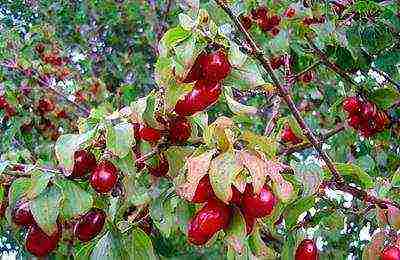 The above species are resistant to frost from -20 to -35 degrees. Thanks to the powerful root system, the plant can recover even after the death of the aerial part. The process of restoring and launching new shoots takes more than one year, therefore, in order to avoid such cases, it is recommended to insulate the fragile shrub for the winter. Although dogwood is not picky about the composition of the soil, it will develop better and faster in nutrient soils rich in lime.
The above species are resistant to frost from -20 to -35 degrees. Thanks to the powerful root system, the plant can recover even after the death of the aerial part. The process of restoring and launching new shoots takes more than one year, therefore, in order to avoid such cases, it is recommended to insulate the fragile shrub for the winter. Although dogwood is not picky about the composition of the soil, it will develop better and faster in nutrient soils rich in lime.
Therefore, the dogwood bush, like any other fruitful plant, needs recharge and mulching of the soil.
The first fruits can be tasted only for 3-5 years of the seedling's life. The number of berries will constantly increase. An adult wild-growing shrub gives about 5-7 kg of fruits, and rather small in size.
Providing proper care and replenishment of the soil, you can achieve 20 kg of harvest or more from a bush aged 14-16 years. Cornel has many useful properties, the description of which can be read a little below.
Characteristics of the best varieties
Most, choosing a variety, first of all start from their taste preferences and the ability to plant the species they like in a certain climate. In addition to the taste of berries, there is another characteristic that many pay special attention to - this is yield.
Below is a description of the most popular varieties that have large fruits, good yields and take root in almost any region of Russia.
Elena
This variety was bred specifically for cold regions, capable of withstanding temperatures down to -35 degrees. Kizil Elena was obtained by crossing the Starokievsky and Vydubitsky varieties in 1975. The main characteristics of the fruits:
 taste - sweet and sour;
taste - sweet and sour;- shape - more often oval, round is found;
- the average weight of one berry is 7-8 grams;
- color - deep red with a slight sheen;
- dense pulp, which lags behind the stone without problems.
Due to their good density, the berries can be transported for up to 30 days. The shrub begins to bear fruit in about the 3rd year. Elena has a high yield, an adult bush is capable of producing 40 kg of berries. The variety is extremely disease resistant. Ripening period - early (end of August).
Elegant
Early ripening variety - early or mid-August. It was bred in 1989 by pollination of the Semyon variety. Withstands frosts down to -25 degrees. Fruit characteristics:
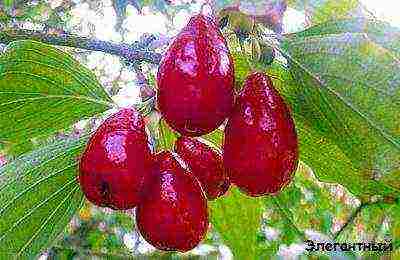 the taste is sweet, with a slight sour tinge;
the taste is sweet, with a slight sour tinge;- shape - oblong, slightly flattened;
- the average weight of one berry is 6-9 grams;
- color - dark red, burgundy;
- the pulp is dense.
It can be in transportation for up to 40 days. The yield is good, it is possible to collect up to 45 kg of dogwood from an adult bush.
Resistance to viruses and diseases is high. The first fruits can be tasted 3-4 years after planting.
Nikolka
Bred in 1992 by pollination of the Yantarny variety. Ripening period is very early, falls on the end of July or mid-August. Young shoots are able to survive frost at -30 degrees. Fruit characteristics:
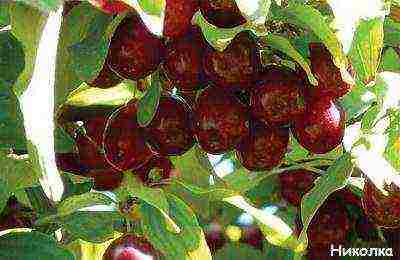 the taste is sweet;
the taste is sweet;- shape - oval, slightly elongated;
- the average weight of one berry is 6-7 grams;
- color - burgundy;
- the pulp is saturated with juice, the density is medium.
The maximum transportation time should not exceed 25 days. A shrub over 15 years old is capable of producing up to 35 kg of harvest. Begins to bear fruit from about 4 years old. Disease resistance is very high.
Alyosha
This variety was bred in 1989 by S.V. Klimenko. The ripening period falls at the beginning of August, sometimes it lasts until September. In the middle lane it feels very comfortable, it can withstand temperatures down to -35. The main characteristics of berries:
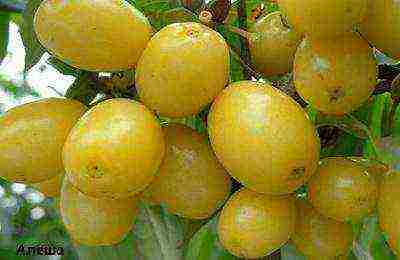 taste - sweet and sour, aftertaste with slight bitterness;
taste - sweet and sour, aftertaste with slight bitterness;- shape - pear-shaped;
- the average weight of one berry is 6-9 grams;
- color - rich yellow;
- the pulp is dense.
The fruits can be transported within 35-40 days. Good disease resistance.
The first fruits appear in the 2nd year after planting. The yield is slightly lower than the previous representatives, an adult bush gives from 20 to 30 kg.
Firefly
The Firefly dogwood is highly prized for its berry flavor and yield. An adult shrub, whose age has exceeded 15 years, is capable of producing more than 50 kg of harvest. In addition, frost resistance is very good. The bush can withstand frosts down to -30. Description of fruits:
 taste - sweet and sour, slightly tart;
taste - sweet and sour, slightly tart;- shape - pear-shaped;
- the average weight of one berry is 6-8 grams;
- color - dark cherry;
- the pulp is very juicy, the density is average.
Transportation should not exceed 25 days. Ripening period - late August, early September. The berries do not crumble. The firefly is often planted as an ornamental variety.the shrub has an attractive pyramidal crown shape, lush foliage and an early flowering period.
Semyon
The variety was bred in 1985; has a late ripening period, which falls at the beginning - end of September. The yield of an adult plant reaches 27 kg. Description of fruits:
 taste - sweet and sour, sour prevails;
taste - sweet and sour, sour prevails;- shape - pear-shaped;
- the average weight of one berry is 6-8.5 grams;
- color - dark red, tends to black;
- the pulp is dense.
In transportation, the fruits can be up to 30 days.
The shrub has an average resistance to frost, withstands up to -20 degrees, so it is better to warm young seedlings for the winter.
Begins to bear fruit at 4-5 years. This variety is resistant to most diseases, but often suffers from powdery mildew.
Vladimirsky
The most productive is the large-fruited Vladimir dogwood. The yield of an adult bush is extremely high, exceeding 60 kg. This species is absolutely not picky about the climatic conditions of the area and develops well in any region of Russia. Description of fruits:
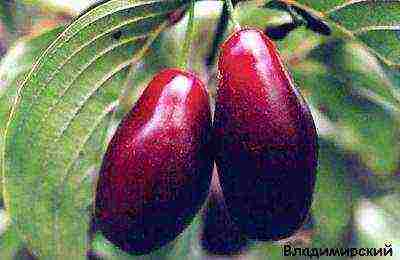 taste - delicate sweet with a sour note;
taste - delicate sweet with a sour note;- shape - oval, slightly oblong;
- the average weight of one berry is 9-11 grams;
- color - deep red, fully ripe berries are almost black;
- pulp of medium density.
The ripening period occurs in mid to late August. Vladimirsky dogwood has good frost resistance, however, young seedlings are recommended to be insulated for the winter for the first two years.
Why is it worth planting dogwood on your site?
This amazing berry will contain a lot of vitamins and useful microelements in its composition. In addition, in folk medicine, not only dogwood pulp is used, but also leaves, branches and even bones. Most use the fruit for antibacterial and anti-inflammatory decoctions. Cornelian tincture lowers blood pressure. Fresh fruits speed up metabolic processes in the body, which helps burn fat.
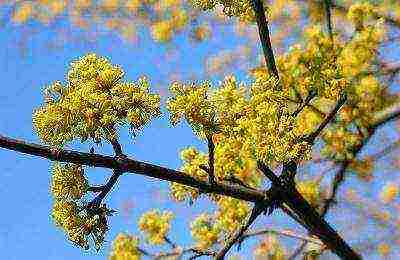 Ripe dogwood helps in the fight against colds, helps to normalize digestion. The berries contain a large amount of pectin, which removes toxins, radiation and toxins from the body. Traditional medicine recommends eating fresh dogwood for severe headaches and in the early stages of the development of multiple sclerosis. In these cases, the fruit, due to its rich mineral and vitamin complex, improves blood supply to the brain and blood circulation in general.
Ripe dogwood helps in the fight against colds, helps to normalize digestion. The berries contain a large amount of pectin, which removes toxins, radiation and toxins from the body. Traditional medicine recommends eating fresh dogwood for severe headaches and in the early stages of the development of multiple sclerosis. In these cases, the fruit, due to its rich mineral and vitamin complex, improves blood supply to the brain and blood circulation in general.
Cornel jam contains a lot of iron, which helps to increase hemoglobin. Cornel strengthens the walls of blood vessels, saturates cells with oxygen, in addition, it is often used in the treatment of such diseases:
- fever;
- various flu;
- scurvy;
- arthritis;
- anemia;
- measles;
- haemorrhoids;
- most skin diseases.
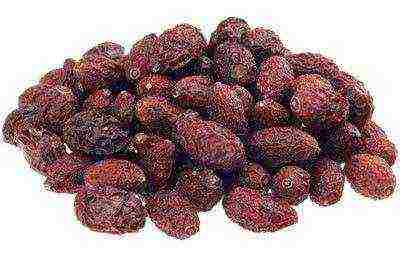 The people use not only fresh dogwood for medical purposes, but also dried dogwood, which is able to retain all its beneficial properties for up to 3 years. Dried fruits are beneficial for diabetes because help lower blood sugar, are used to make pain relievers. Special tinctures of dried dogwood are used as a lotion for dry and flaky skin.
The people use not only fresh dogwood for medical purposes, but also dried dogwood, which is able to retain all its beneficial properties for up to 3 years. Dried fruits are beneficial for diabetes because help lower blood sugar, are used to make pain relievers. Special tinctures of dried dogwood are used as a lotion for dry and flaky skin.
Shrub leaves can be applied to inflamed areas of the skin, to places where the rash appears.
Tea made from dogwood flowers and leaves helps with fever and frequent diarrhea.
You can get rid of pain and breakage in the joints by preparing a special bath, to which a decoction of bark and green leaves is added at the rate of 5 tablespoons per liter of water. The bark and leaf tincture is used as a natural diuretic and also helps cleanse the liver. Tinctures are prepared from the seeds that help with mental disorders. Also, this broth acts as a sedative.
Cornel is one of the most unpretentious fruit-bearing shrubs in terms of climatic conditions.But in order to get the richest harvest possible, you need to provide proper care for the plant in the first years of its life. A young seedling needs feeding, cutting and loosening the soil. Paying due attention to these aspects, in the future, the plant will reward an abundant amount of delicious berries.

about the author
Helpful article?
(
votes, average:
out of 5)
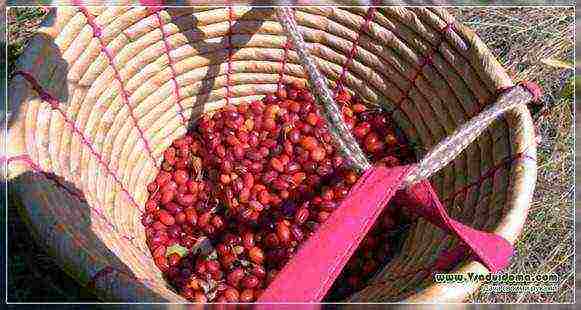
Juicy dogwood berries are a natural cure for many diseases. Plant this amazing plant! N. Khromov, Candidate of Agricultural Sciences, Michurinsk. Tambov region
Dogwood is a promising crop, primarily for the southern regions of our country. For example, Michurinsk, where I work, is suitable for growing dogwood, but often the taste of its fruits is not as sweet as in the south. therefore
The Tambov region can be called the extreme northern zone for the cultivation of this crop.
Soil and fertilizer for dogwood
Cornel grows best on loose soil, sufficiently moist, almost sandy. Fertilizers are applied once a year, usually in spring, during the flowering period. Under each bush (up to 5 years old) apply 15-20 g of any complex fertilizer dissolved in 10 liters of water, under older bushes - 25-30 g each.
As soon as the fruits begin to set, it is advisable to add potassium sulfate (15-20 g for each plant) or wood ash (250-300 g for a bush). The fact is that wood ash contains up to 5% potassium, which is needed by dogwood for the full formation of fruits.
Loosening and watering
It is necessary to loosen the ground around the dogwood very carefully, breaking the soil crust, while trying not to damage the roots, which are located close to the surface, literally weave under it.
To prevent the roots from overheating in the summer heat, carry out evening watering with cool water - this will cool the soil.
See also: Cornelian cherry (photo) strawberry tree - planting and growing
Dogwood propagation
The best option for breeding dogwood is green cuttings. Cuttings 12-15 cm long should be cut at the beginning of June and placed in a greenhouse covered with foil. Leave no more than a couple of leaves on the cuttings, remove the rest.
Dogwood surprises with the fact that it blooms before the snow melts, and the fruits ripen fully when the snow cover already falls.
The soil should consist of expanded clay at the base, as well as a mixture of humus, river sand and nutrient soil in equal proportions. On top of this mixture, lay sand 2-3 cm thick. Place the cuttings in it, deepening the lower end by a couple of centimeters, and cover the greenhouse itself with a film.
Under the condition of watering 5-6 times a day, the roots are formed on 45-50% of the seedlings. Further, seedlings with roots need to be transplanted to a nutritious bed for growing. The next year, the rooted cuttings can be planted in open ground.
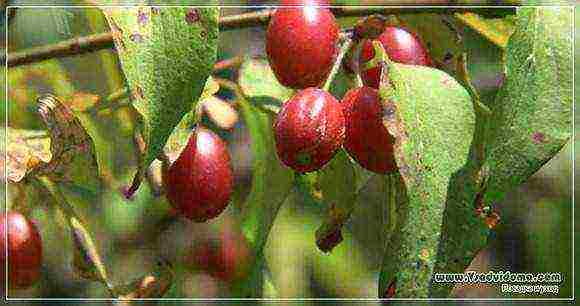
Dogwood varieties are the best
Currently, there are 5 varieties of dogwood in the State Register of Breeding Achievements, and there are also supernovae. So, variety Prikubansky can be called an "old man", it was received in 2004; the rest of the varieties are new in 2017. This is Artemy, Nastya, Samokhvalovsky and Solnechny.
It ripens in medium terms and has a versatile purpose. It has a low bush with a sparse, slightly drooping crown. The fruits are elongated pear-shaped, dark red in color, reaching a mass of 5.5 g. The flesh of scarlet is very tender and juicy, the taste is sweet and sour, although in the south it is sweeter. The fruits contain a large amount of ascorbic acid - up to 25.5 mg%.
In the conditions of the Tambov region and to the south, the variety is winter-hardy, does without shelter, does not get sick and is not yet affected by pests.
Nastya
It differs in fruits weighing about 5.1 g, drop-shaped and scarlet in color.
The pulp is slightly rough. The content of ascorbic acid is up to 123 mg%.
Artemy
Fruit weight reaches 6.3 g. The shape of the berries is bottle-shaped, the color is dark red. The pulp is a little rough, but very tasty. The content of ascorbic acid is up to 117 mg%.
Samokhvalovsky
Fruits weighing up to 7.6 g, pear-shaped, almost black.The pulp is sweet and sour, pleasant to the taste. The content of ascorbic acid is up to 143 mg%.
Solar
Fruits weighing up to 4.2 g, oval and yellow. The pulp is very tender, it literally melts in your mouth. The content of ascorbic acid is up to 120 mg%.
In the conditions of the Tambov region and to the south, these varieties winter without shelter.
Be careful when gardening: touching dogwood foliage with your bare body can cause irritation and itching.
See also: Dogwood (photo) the benefits of the variety and care
Growing dogwood - video
Below are other entries on the topic "Cottage and garden - do it yourself"
How I grow dogwood: Growing dogwood - my advice Childhood ... Cornelian cherry berry - growing and useful properties of dogwood: Growing dogwood Common dogwood is the oldest ... Cornelian cherry (photo) variety benefits and care: Growing dogwood, benefits and care ... tree - planting and growing: Strawberry tree - planting and ... Plum varieties for the Far East: Plum varieties for Primorye Primorsky Krai ... Multi-tiered onions (photo) best varieties, planting and care: Growing varieties and caring for ... Growing dogwood in the country and caring for it : Dogwood is frosty and ...
Subscribe to updates in our groups.
Let's be friends!
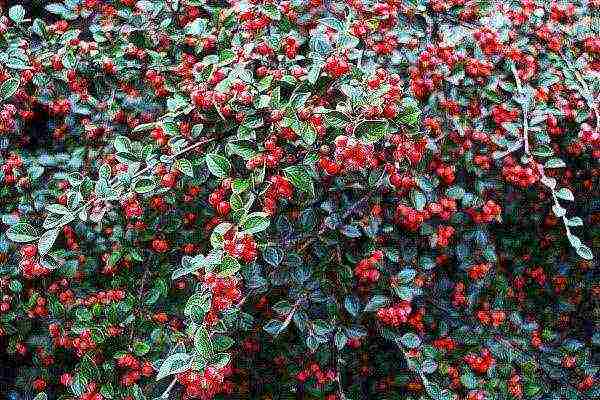 Dogwood is one of the long-livers that have been undeservedly ignored by gardeners, capable of growing in one place for more than 200 years. Having begun to bear fruit at a relatively late (compared to other crops) age of about 10 years, it gives its tasty and healthy berries for more than 2/3 of its life period, and only the last few decades the bush has been resting. How to grow such a culture on your site and what needs to be considered when planting and caring for it, we will talk about this today.
Dogwood is one of the long-livers that have been undeservedly ignored by gardeners, capable of growing in one place for more than 200 years. Having begun to bear fruit at a relatively late (compared to other crops) age of about 10 years, it gives its tasty and healthy berries for more than 2/3 of its life period, and only the last few decades the bush has been resting. How to grow such a culture on your site and what needs to be considered when planting and caring for it, we will talk about this today.
"Who is" dogwood?
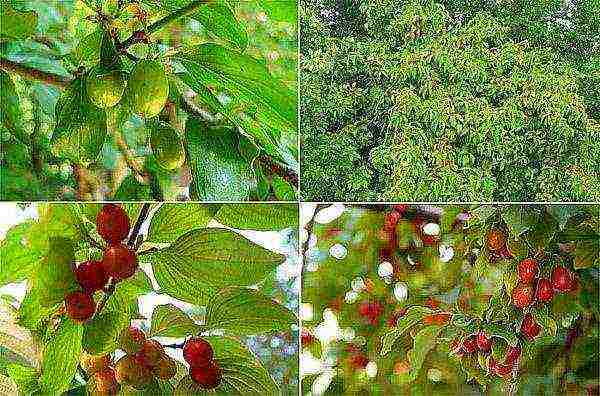 Dogwood is a fairly tall shrub, the height of which depends on the climate in which it grows. On average, the "growth" of bushes is about 3 m, although there are often taller 8-meter comrades, more like trees.
Dogwood is a fairly tall shrub, the height of which depends on the climate in which it grows. On average, the "growth" of bushes is about 3 m, although there are often taller 8-meter comrades, more like trees.
Regardless of the species, woody or bushy variety, in the "childhood" age all plants actively grow young shoots, painted in yellow-green color, but, "growing up", the branches are covered with gray wrinkled bark, which turns red over time. The crown of the bush is round or in the form of a pyramid, and the leaves have an elongated shape and a sharp tip. The leaf plate is painted on top in a bright green light with a slight gloss, while on the bottom it is lighter and more dull.
The leaf plate is painted on top in a bright green light with a slight gloss, while on the bottom it is lighter and more dull.
Blooming dogwood is no less decorative: yellow lush umbrellas of inflorescences bloom in early spring, in March, and before the leaves peep out of the buds on the branches.
Is the berry sweet?
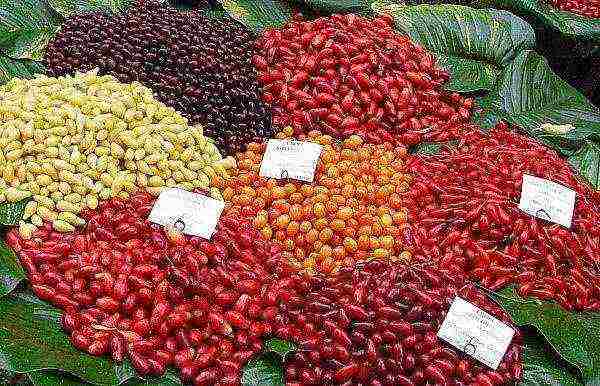 At the end of summer - at the beginning of autumn, elongated berries begin to ripen on the bushes: they are small, up to a maximum of 4 cm in length and up to 8 g each in weight, but with very tasty and juicy pulp. The taste is dominated by sourness and a tart note is clearly felt. It has been noticed that the berries left on the bushes during the autumn frosts become sweeter.
At the end of summer - at the beginning of autumn, elongated berries begin to ripen on the bushes: they are small, up to a maximum of 4 cm in length and up to 8 g each in weight, but with very tasty and juicy pulp. The taste is dominated by sourness and a tart note is clearly felt. It has been noticed that the berries left on the bushes during the autumn frosts become sweeter.
The color of the berries depends on the variety, but they are mostly bright red, although breeders have bred yellow, white and different shades of red dogwood. All of them are very tasty and extremely healthy due to the rich composition of trace elements. Excellent compotes and preserves, wines and syrups are prepared from dogwood berries, as well as dried, dried and frozen. In addition, dogwood has a number of medicinal properties, which makes it an indispensable aid in the treatment of many diseases.
To prepare berries for future use, it is better to pick them when the dogwood is just beginning to ripen. Folded in boxes or wicker baskets, green berries ripen right in them.
Where can you find dogwood?
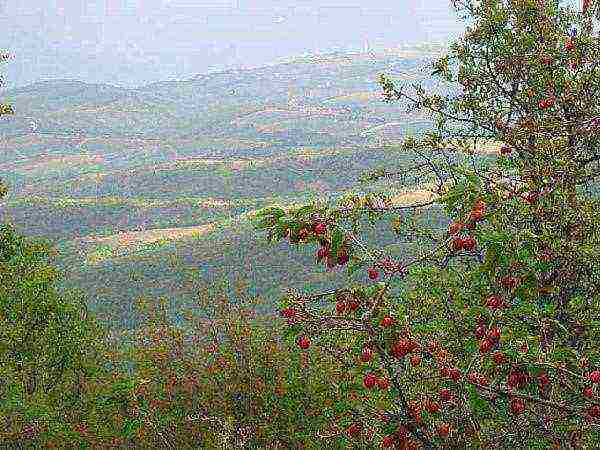 The perennial prefers thermophilic climatic conditions and among the places where dogwood grows, it is worth noting, first of all, the mountain forests of the Transcaucasia, the Caucasus and Transcarpathia. Also, a lot of wild-growing dogwood is observed on the territory of the Crimea.In the indicated area, the culture has the most optimal conditions in which it bears fruit successfully.
The perennial prefers thermophilic climatic conditions and among the places where dogwood grows, it is worth noting, first of all, the mountain forests of the Transcaucasia, the Caucasus and Transcarpathia. Also, a lot of wild-growing dogwood is observed on the territory of the Crimea.In the indicated area, the culture has the most optimal conditions in which it bears fruit successfully.
The persistent character of a perennial does not prevent it from growing even among rocks, however, this leaves an imprint on the appearance of the plant. For example, in Armenia, a dogwood in the form of a short-stemmed low tree looks out directly from rock crevices.
On the territory of Russia, perennial is also used everywhere as an ornamental plant, since it has a good overall frost resistance. However, the characteristic nuances of the growing season also require a certain approach to cultivation, especially if it is planned not only to get a beautiful hedge, but also to wait for ripe red berries.
Dogwood blooms very early, and the harvest ripens for a long time (more than 200 days).
In this regard, in central Russia, it is better to plant early maturing varieties of dogwood, otherwise the ovary may suffer from recurrent frosts or the berries will not have time to ripen before the onset of autumn frosts.
Features of cultural cultivation
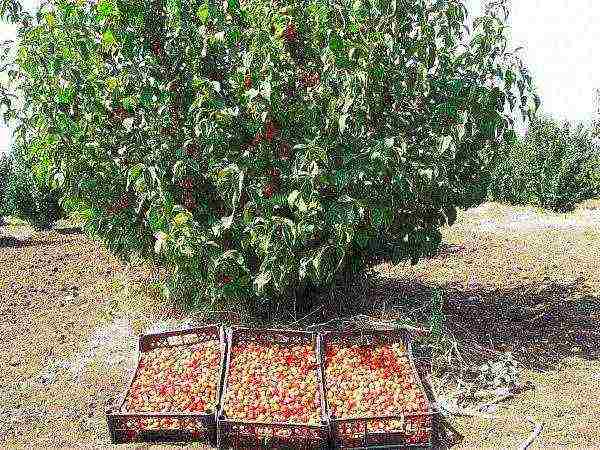 Planting and caring for dogwood will not cause much trouble if you responsibly choose the variety and place for the shrub. Only dogwood varieties that are capable of growing and bearing fruit in the local climate should be planted unambiguously. For example, in the middle latitudes, late-ripening dogwood species will not have time to ripen before the arrival of winter, which means that early varieties should be preferred.
Planting and caring for dogwood will not cause much trouble if you responsibly choose the variety and place for the shrub. Only dogwood varieties that are capable of growing and bearing fruit in the local climate should be planted unambiguously. For example, in the middle latitudes, late-ripening dogwood species will not have time to ripen before the arrival of winter, which means that early varieties should be preferred.
When choosing a place for planting a perennial, it is better to stay in the southwestern section, which meets the following requirements (there the dogwood will grow well and bear fruit abundantly):
- groundwater is no closer than one and a half meters;
- the soil is fertile and not acidic.
It is necessary to plant dogwood at a distance of at least 5 meters from fences and trees, so that the crown can receive full-fledged lighting, and the bush has room to grow.
Dogwood in the gardens of Belarus
 Separately, it is worth mentioning the cultivation of thermophilic dogwood in Belarus - the local cold climate requires a special approach, in particular, it is better to start planting seedlings in spring, so that they have time to get stronger by winter. Those plants that are formed in the form of a shrub survive the winter best, but even they need to be covered if the average temperature in winter drops below 30 degrees below zero. To do this, the shoots are bent to the ground and the bush is covered with spruce branches.
Separately, it is worth mentioning the cultivation of thermophilic dogwood in Belarus - the local cold climate requires a special approach, in particular, it is better to start planting seedlings in spring, so that they have time to get stronger by winter. Those plants that are formed in the form of a shrub survive the winter best, but even they need to be covered if the average temperature in winter drops below 30 degrees below zero. To do this, the shoots are bent to the ground and the bush is covered with spruce branches.
As a garden and berry crop, the main purpose of which is fruiting, such early varieties of dogwood with ripening at the end of summer have proven themselves well on the territory of Belarus:
- Coral Stamp. Unusual dark pink berries with an orange tint ripen in the second half of August.

- Elegant. The first harvest is already at the end of July. The cherry-colored berries are in the shape of a bottle with a narrow neck and do not crumble until frost. Differs in low growth (no more than 2 m in height).

- Mid-season variety Vladimirsky. One of the largest-fruited species of dogwood, the weight of one almost black berry is about 10 g, the shape is rounded, slightly flattened. Ripening begins in the third decade of August.
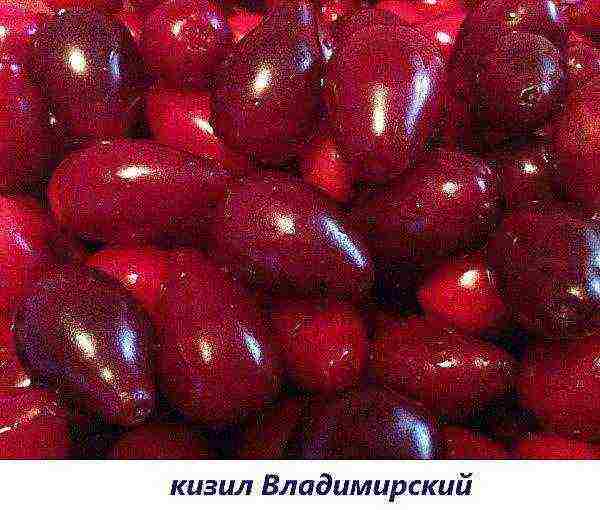
Dogwood in the suburbs
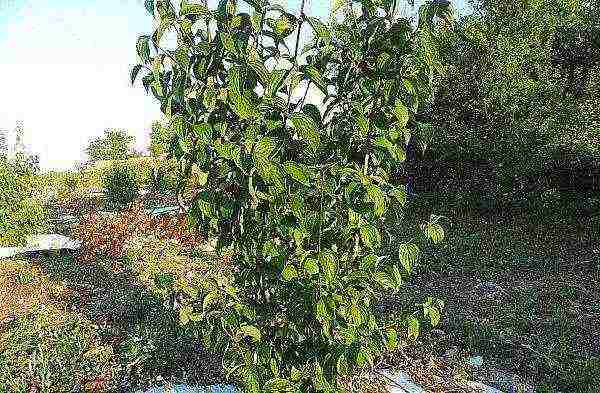 Spring planting of seedlings is also recommended when growing dogwood in the Moscow region, where the winters are also cold. But local gardeners can boast of an abundance of snowfalls, which simplify measures to protect shrubs from frost: if the average winter temperature is up to 30 degrees below zero, it is enough to “barricade” the bushes with a snowdrift.
Spring planting of seedlings is also recommended when growing dogwood in the Moscow region, where the winters are also cold. But local gardeners can boast of an abundance of snowfalls, which simplify measures to protect shrubs from frost: if the average winter temperature is up to 30 degrees below zero, it is enough to “barricade” the bushes with a snowdrift.
Of the frost-resistant varieties that grow well and bear fruit in the conditions of the Moscow region, it is worth noting:
- Nikolka. The dark red sweet berries ripen in early August.
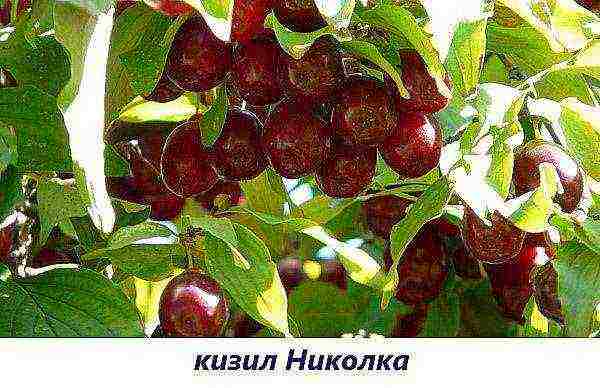
- Grenadier. High-yielding variety (up to 45 kg of berries from one bush). Red elongated berries ripen in the first decade of August, taste sweet and sour.
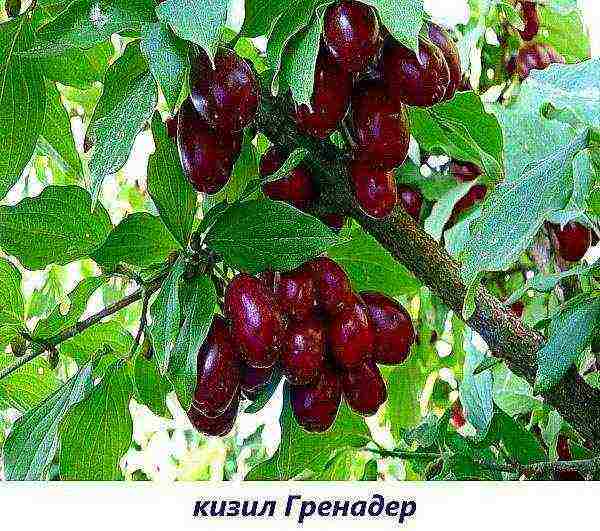
- Elena. At the end of August, you can pick dark red, slightly oval, sweet-fleshed berries.
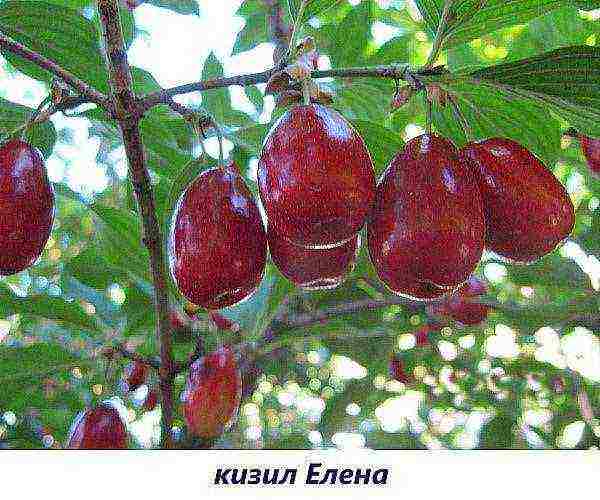
How to plant a seedling correctly?
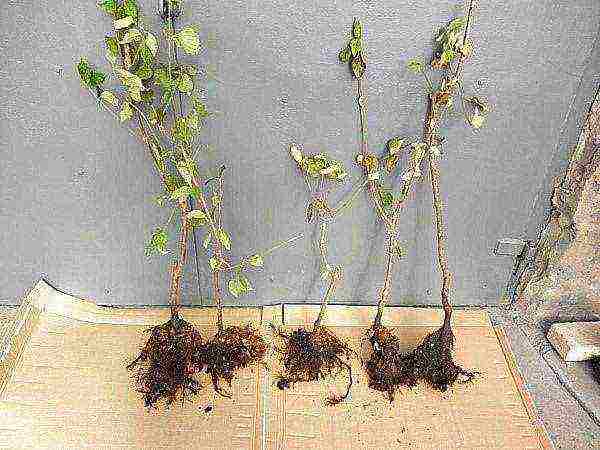 The most convenient way to grow dogwood is with seedlings, which can be purchased at a local nursery, where there is always a large selection of zoned varieties. What does a dogwood seedling look like? It should be:
The most convenient way to grow dogwood is with seedlings, which can be purchased at a local nursery, where there is always a large selection of zoned varieties. What does a dogwood seedling look like? It should be:
- not older and not younger than 2 years old:
- with a well-developed root system;
- up to 1.5 m high;
- with a stem diameter up to 2 cm;
- with at least 5 mature skeletal branches.
The optimal planting time is autumn. For a seedling, dig a planting hole 60 * 60 cm in size.Mix the top layer of soil with mineral fertilizers and humus and cover the bush, deepening the root collar no more than 3 cm above the soil level (after the earth settles, the collar should be equal to it). After watering, mulch the trunk circle and it is advisable to shorten the shoots near the bush, leaving 2/3 of their length.
Planting dogwood must be carried out in pairs, at a distance of 3 to 5 m from each other. This is necessary for pollination, because in early spring, when the perennial blooms, it is still cold outside and the bees have not yet begun their work.
Nuances of seed growing dogwood
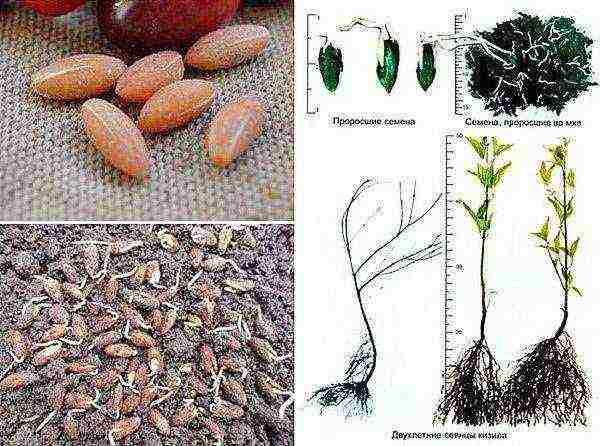 For those who like to experiment, you can try to grow a useful perennial from drupes. This procedure is quite lengthy, since they sprout for a very long time, but it will come in handy if it is problematic to purchase a ready-made seedling.
For those who like to experiment, you can try to grow a useful perennial from drupes. This procedure is quite lengthy, since they sprout for a very long time, but it will come in handy if it is problematic to purchase a ready-made seedling.
What should you pay attention to and how to grow a dogwood from a stone? First of all, this is the stratification of seeds: after harvesting, remove the pulp from ripe berries, rinse them and place them in a container with sawdust. Over the next year, the drupes should be there, while it is important to constantly maintain a high level of humidity by regularly moistening the sawdust.
Stratified drupes emerge in the year of planting, whereas without this procedure, seedlings should be expected for at least two years.
Prepared dogwood seeds must be planted in nutrient soil and looked after as usual: water, fertilize. It is worth taking into account the rate of how the dogwood grows from the seeds: in two years after germination, the seedling will stretch only 15 cm.But the harvest from such a plant can be obtained no earlier than in 7 years. For this reason, gardeners are looking for every opportunity to buy seedlings. Buying full-fledged dogwood bushes allows you to save yourself the hassle of growing and bring fruiting closer.
Easy bush care
 Growing and caring for dogwood is generally not a troublesome business. In the first year, young bushes need frequent watering, with age, the perennial is already able to stay for a longer time without additional moisture. After each watering, the soil must be loosened to avoid rapid evaporation of moisture. You will also need to pull out the weeds so that they do not drown the plant. In general, everything is like other horticultural crops.
Growing and caring for dogwood is generally not a troublesome business. In the first year, young bushes need frequent watering, with age, the perennial is already able to stay for a longer time without additional moisture. After each watering, the soil must be loosened to avoid rapid evaporation of moisture. You will also need to pull out the weeds so that they do not drown the plant. In general, everything is like other horticultural crops.
Separately, it is worth highlighting the formation of the crown - its future contour is set even during planting or in the first year of the seedling's life, leaving a 50-centimeter stem and from 5 to 7 skeletal branches. In the future, every spring, it is necessary to carry out sanitary pruning, cutting out young shoots, damaged branches that thicken the crown, growing inside the bush or intersecting with each other.
When the dogwood is 20 years old, the bush can be rejuvenated by cutting out branches at the age of 4 years - this will stimulate the formation of new shoots.
As for fertilizing, the perennial develops well without them, especially in fertile soil, however, for good yields, it is still recommended to fertilize the dogwood. The feeding scheme is as follows:
- in the spring - nitrogen-phosphorus preparations;
- in the summer - organic (infusion of chicken droppings);
- in the fall - humus and potash fertilizers, as well as ash for digging a trunk circle.
Dogwood growing in the home garden is most often propagated vegetatively as the most effective and quickest result, namely:
- cuttings;
- layering;
- vaccination.
In conclusion, I would like to say that tasty and healthy dogwood berries must necessarily be on the site for every summer resident.This perennial will not only decorate it, but also provide its owners with natural vitamins, and more than one generation will enjoy them.
The most important thing about dogwood - video
